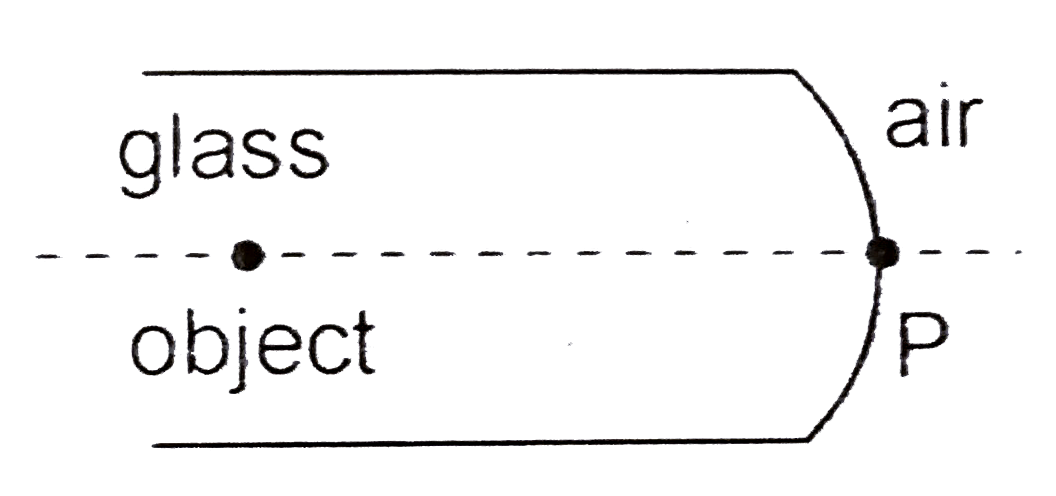Show that for refraction at a concave spherical surface (separating glass-air medium), the distance of the object should be greater than three times the radius of curvature of the refracting surface for the image to be real.
To show that for refraction at a concave spherical surface (separating glass and air), the distance of the object should be greater than three times the radius of curvature of the refracting surface for the image to be real, we can follow these steps:
Step 1: Understand the Setup
We have a concave spherical surface separating two media: glass (with refractive index μ1) and air (with refractive index μ2). The object is placed in the glass medium.
Step 2: Define the Variables
- Let R be the radius of curvature of the concave surface.
- Let u be the object distance (measured from the surface).
- Let v be the image distance (measured from the surface).
- The refractive indices are μ1=32 (for glass) and μ2=1 (for air).
Step 3: Apply the Refraction Formula
Using the formula for refraction at a spherical surface, we have:
μ2v−μ1u=μ1−μ2R
Substituting the values of μ1 and μ2:
1v−3/2−u=3/2−1R
This simplifies to:
1v+32u=1/2R
Step 4: Rearranging the Equation
Rearranging the equation gives:
1v=12R−32u
To combine the fractions:
1v=u−3R2Ru
Step 5: Condition for a Real Image
For the image to be real, v must be greater than 0:
1v>0⟹u−3R>0⟹u>3R
Conclusion
Thus, we have shown that for the image to be real, the object distance u must be greater than three times the radius of curvature R:
u>3R
---
We have a concave spherical surface separating two media: glass (with refractive index μ1) and air (with refractive index μ2). The object is placed in the glass medium.
- Let R be the radius of curvature of the concave surface.
- Let u be the object distance (measured from the surface).
- Let v be the image distance (measured from the surface).
- The refractive indices are μ1=32 (for glass) and μ2=1 (for air).
Using the formula for refraction at a spherical surface, we have:
μ2v−μ1u=μ1−μ2R
Substituting the values of μ1 and μ2:
1v−3/2−u=3/2−1R
This simplifies to:
1v+32u=1/2R
Rearranging the equation gives:
1v=12R−32u
To combine the fractions:
1v=u−3R2Ru
For the image to be real, v must be greater than 0:
1v>0⟹u−3R>0⟹u>3R
Thus, we have shown that for the image to be real, the object distance u must be greater than three times the radius of curvature R:
u>3R
Topper's Solved these Questions
- RAY OPTICS AND OPTICAL INSTRUMENTSBOOK - AAKASH INSTITUTECHAPTER - RAY OPTICS AND OPTICAL INSTRUMENTSEXERCISE - EXERCISE
47 Videos
- RAY OPTICS AND OPTICAL INSTRUMENTSBOOK - AAKASH INSTITUTECHAPTER - RAY OPTICS AND OPTICAL INSTRUMENTSEXERCISE - ASSIGNMENT (SECTION - A)
42 Videos
- RAY OPTICS AND OPTICAL INSTRUMENTSBOOK - AAKASH INSTITUTECHAPTER - RAY OPTICS AND OPTICAL INSTRUMENTSEXERCISE - Assignment (Section - J) Aakash Challengers Questions
7 Videos
- PHYSICAL WORLDBOOK - AAKASH INSTITUTECHAPTER - PHYSICAL WORLDEXERCISE - ASSIGNMENT (Section-B)
5 Videos
- SEMICONDUCTOR ELECTRONICS (MATERIAL, DEVICES AND SIMPLE CIRUITS )BOOK - AAKASH INSTITUTECHAPTER - SEMICONDUCTOR ELECTRONICS (MATERIAL, DEVICES AND SIMPLE CIRUITS )EXERCISE - Assignment SECTION - D (Assertion & reason type Question)
10 Videos
Similar Questions
A spherical convex surface separates object and image space of refractive index 1.0 and 4/3. If radius of curvature of the surface is 10cm, find its power.
View SolutionA spherical convex surface separates object and image space of refractive index 1.0and43. If radius of curvature of the surface is 10cm, find its power.
View Solution
Knowledge Check
Refraction takes place at a concave spherical boundary separating glass air medium. For the image to be real, the object distance (μg=3/2)
Ashould be greater than three times the radius of curvature of refracting surfaceBshould be greater than two times the radius of curvature of the refracting surfaceCshould be greater than the radius of curvature of refracting surfaceDis independent of the radius of curvature of the refracting surfaceRefraction takes place at a convex spherical boundary separating glass-air medium. For the image to be real, the object distance (μg=3/2) should be /is
Agreater than three times the radius of curvature of the refracting surfaceBgreater than two times the radius of curvature of the refracting surfaceCgreater than the radius of curvature of the refracting surfaceDindependent of the radius of curvature of the refracting surfaceA spherical convex surface separates object and image space of refractive index 1 and 43 respectively. If radius of curvature of the surface is 0.1 m, its power is
A2.5DB-2.5 DC3.3DD-3.3D
Derive the mathematical relation between refractive indices n1 and n2 of two media and radius of curvature R for refraction at a convex spherical surface. Consider the object to be a point one lying on the principal axis in rarer medium of refractive index nt and a real image formed in the denser medium of refractive index n2. Hence, derive lens maker's formula.
(ii) Light from a point source in air falls on a convex spherical glass surface of refractive index 1.5 and radius of curvature 20 cm. The distance of light source from the glass surface is 100 cm. At what position is the image formed ?
View SolutionThe minimum sum of the distances of a real object and a real image from a concave mirror of radius of curvature 20cm is:
View SolutionRefraction takes place at a convex spherical boundary separating air-glass medium. For the image to be real, the object distance (μg=3/2)
Note Object lying in the glass.
View SolutionA spherical convex surface separates object and image spaces of refractive indices 1.0 and 4/3 . If radius of curvature of the surface is 10cm, find its power.
View SolutionRadius of curvature of a concave spherical surface separating air-glass medium is R. A point object is placed on the principal axis in the glass (mg=1.5). For the image to be real seen by

observer in air, distance of the object from P should be
View Solution
